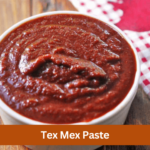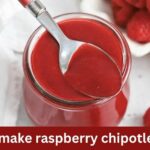In the world of culinary delights, chipotle paste stands out as a versatile and flavorful ingredient that can elevate your dishes to new heights. Whether you’re a seasoned chef or an amateur cook, mastering the art of making chipotle paste can add depth, smokiness, and a touch of heat to your recipes. In this comprehensive guide, we’ll delve into the nuances of crafting this delectable paste from scratch, exploring its ingredients, preparation methods, and storage tips. So grab your apron and let’s embark on a culinary journey to discover the secrets of homemade chipotle paste!
Before we dive into the nitty-gritty of making chipotle paste, let’s take a moment to understand what this magical ingredient is all about. Chipotle paste is a rich and smoky condiment made from puréed chipotle chilies, which are essentially dried and smoked jalapeños. This paste typically includes a blend of chipotle peppers, adobo sauce, and sometimes additional ingredients such as onion, garlic, and spices. The result is a thick, flavorful paste with a hint of sweetness and a fiery kick.
What Makes Chipotle Paste Special?
Chipotle paste adds depth, complexity, and a smoky flavor to a wide range of dishes. Its versatility makes it a staple in Mexican cuisine, where it’s used to spice up everything from soups and stews to marinades and sauces. Unlike whole chipotle chilies, which require chopping and can vary in heat level, chipotle paste offers consistent flavor and heat, making it easy to incorporate into your recipes.
Ingredients for Homemade Chipotle Paste

Making chipotle paste at home requires just a few simple ingredients, many of which you may already have in your pantry. Here’s what you’ll need:
- Canned Chipotles in Adobo Sauce:
- Quantity: 7 ounces (approximately 200 grams)
- Chipotles in adobo sauce are the primary ingredient for chipotle paste. This canned product typically contains chipotle peppers that have been dried and smoked, then rehydrated and preserved in a tangy, spicy adobo sauce. The amount specified is for a standard 7-ounce can, but you can adjust the quantity based on your preference for spiciness and the desired yield of chipotle paste.
- Water:
- Quantity: As needed
- Water is used to help blend the chipotles into a smooth paste. The amount required may vary depending on the thickness of the adobo sauce and the desired consistency of the paste. Start with a small amount and gradually add more if necessary until the desired texture is achieved.
- Optional Additions (Customization):
- While the basic chipotle paste recipe only requires chipotles in adobo sauce and water, you can customize the flavor profile by adding additional ingredients. Some common optional additions include:
- Onion: 1 small onion, roughly chopped
- Garlic: 2 cloves, minced
- Spices: Such as cumin, paprika, or oregano, to taste
- Sweeteners: Such as honey or sugar, for a touch of sweetness
- Quantity: These optional additions can be adjusted according to personal preference. Start with small amounts and adjust to taste during blending.
- While the basic chipotle paste recipe only requires chipotles in adobo sauce and water, you can customize the flavor profile by adding additional ingredients. Some common optional additions include:
Step-by-Step Guide to Making Chipotle Paste
Step 1: Gather Your Equipment
Before you begin preparing the chipotle paste, it’s essential to gather all the necessary equipment. Here’s what you’ll need:
- Blender or Food Processor: You’ll require a sturdy blender or food processor capable of blending the chipotle peppers into a smooth paste. Ensure that the appliance is clean and in good working condition.
- Jar or Container: Select a clean, airtight jar or container to store the chipotle paste once it’s prepared. This will help maintain its freshness and flavor.
Step 2: Prepare the Chipotles
Once you have your equipment assembled, it’s time to prepare the chipotles for blending. Here’s what you’ll do:
- Open the Can: Begin by opening the can of chipotles in adobo sauce using a can opener. Carefully remove the lid and discard any excess liquid from the can.
- Drain Excess Liquid: Use a strainer or colander to drain any remaining liquid from the chipotles. This will help prevent the paste from becoming too watery during blending.
- Transfer to Blender or Food Processor: Transfer the drained chipotles to the blender or food processor. If the chipotles are particularly large or have tough stems, you may want to remove them before blending.
Step 3: Blend Until Smooth

With the chipotles in the blender or food processor, it’s time to start blending. Follow these steps to achieve a smooth and creamy consistency:
- Secure the Lid: Ensure that the lid of the blender or food processor is securely in place to prevent any spills or splatters.
- Begin Blending: Start the blender or food processor on a low setting, gradually increasing the speed to high. Blend the chipotles until they form a smooth paste, scraping down the sides of the container as needed to ensure even blending.
- Adjust Consistency: If the paste appears too thick or difficult to blend, you can add a small amount of water to help loosen it up. Be cautious not to add too much water, as this can dilute the flavor of the paste.
Step 4: Taste and Adjust Seasoning
Once the chipotle paste is blended to your desired consistency, it’s time to taste and adjust the seasoning. Here’s what you’ll do:
- Taste the Paste: Use a clean spoon to sample the chipotle paste and assess its flavor profile. Pay attention to the level of spiciness, smokiness, and overall seasoning.
- Adjust as Needed: Depending on your taste preferences, you may want to adjust the seasoning of the chipotle paste. You can add additional chipotles for more heat, spices for extra flavor, or a touch of sweetness with honey or sugar.
Step 5: Store Your Chipotle Paste
Once the chipotle paste is blended to perfection and seasoned to your liking, it’s time to store it for future use. Follow these steps to ensure proper storage:
- Transfer to Container: Carefully transfer the chipotle paste to a clean jar or container with a tight-fitting lid.
- Refrigerate or Freeze: Store the chipotle paste in the refrigerator for immediate use, or freeze it for longer-term storage. If freezing, consider portioning the paste into ice cube trays for convenient portioning.
Tips for Using Chipotle Paste in Your Recipes

1. Marinades and Rubs:
- Enhance Flavor: Use chipotle paste as a base for marinades and rubs for meats, poultry, seafood, or vegetables. Its smoky, spicy flavor will infuse your dishes with depth and complexity.
- Versatility: Experiment with different combinations of ingredients, such as citrus juices, herbs, and spices, to create custom marinades that complement your chosen protein.
2. Sauces and Dips:
- Spicy Kick: Stir chipotle paste into sauces, salsas, or dips for a spicy kick. Its rich, smoky flavor pairs well with creamy ingredients like sour cream or Greek yogurt.
- Customization: Adjust the amount of chipotle paste to control the level of heat in your sauces and dips. Start with a small amount and add more gradually until you reach your desired level of spiciness.
3. Soups and Stews:
- Depth of Flavor: Add a spoonful of chipotle paste to soups, stews, or chili for an extra layer of flavor. Its smoky undertones will complement hearty ingredients like beans, tomatoes, and root vegetables.
- Balancing Heat: Be mindful of the heat level when adding chipotle paste to soups and stews. Start with a small amount and taste as you go, adjusting the quantity to suit your preference.
4. Spread and Condiments:
- Flavorful Spreads: Mix chipotle paste with softened butter or cream cheese to create flavorful spreads for bread, crackers, or sandwiches. The combination of smoky chipotle and creamy dairy will tantalize your taste buds.
- Creative Combinations: Experiment with different flavor pairings by adding ingredients like roasted garlic, fresh herbs, or citrus zest to your chipotle spreads.
5. Baking and Roasting:
- Unexpected Twist: Surprise your taste buds by incorporating chipotle paste into baked goods or roasted vegetables. Its smoky, spicy flavor can add an unexpected twist to sweet or savory dishes alike.
- Balancing Act: When using chipotle paste in baking or roasting, consider how its flavor will interact with other ingredients. Balance the spiciness of the chipotle with sweetness or acidity for a harmonious result.
6. Salad Dressings:
- Bold Dressings: Create bold and flavorful salad dressings by whisking chipotle paste with olive oil, vinegar, citrus juice, and seasonings. Drizzle over mixed greens, roasted vegetables, or grain salads for a zesty kick.
- Creamy Options: Blend chipotle paste with mayonnaise or Greek yogurt to create creamy dressings that can elevate simple salads to gourmet status.
7. Grilling and Barbecuing:
- Grilling Marinades: Use chipotle paste as a marinade for meats, poultry, or vegetables before grilling or barbecuing. Its bold flavor will develop a delicious crust and caramelization on the grill.
- Basting Sauces: Brush chipotle paste onto grilled foods during cooking to add a final layer of flavor and moisture. The heat of the grill will intensify the smoky notes of the chipotle paste.
Conclusion
Congratulations! You’ve now mastered the art of making chipotle paste from scratch. With just a few simple ingredients and a bit of creativity, you can elevate your culinary creations to new heights with this versatile and flavorful condiment. Whether you’re adding a spoonful to your favorite marinade, stirring it into a creamy dip, or using it to spice up your soups and stews, chipotle paste is sure to become a staple in your kitchen. So go ahead, experiment with different flavors and recipes, and unleash your inner chef with homemade chipotle paste!






